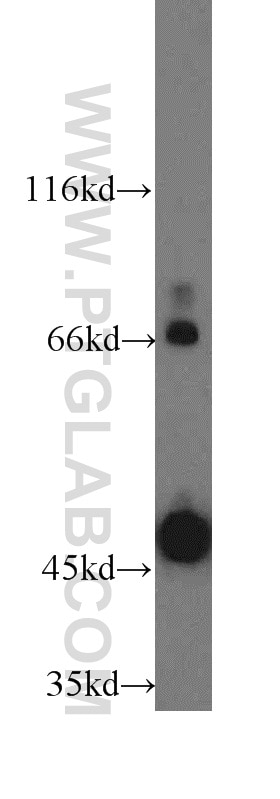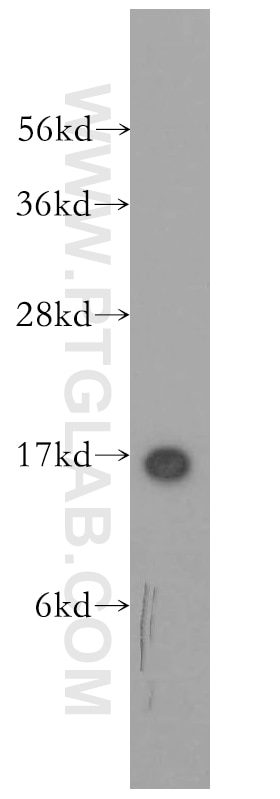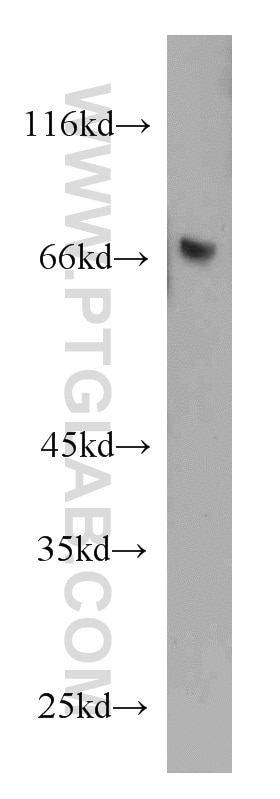Anticorps Polyclonal de lapin anti-SH2D1B
SH2D1B Polyclonal Antibody for IF, IHC, ELISA
Hôte / Isotype
Lapin / IgG
Réactivité testée
Humain, rat, souris
Applications
IHC, IF/ICC, CoIP, ELISA
Conjugaison
Non conjugué
N° de cat : 11871-1-AP
Synonymes
Galerie de données de validation
Applications testées
| Résultats positifs en IHC | tissu rénal humain il est suggéré de démasquer l'antigène avec un tampon de TE buffer pH 9.0; (*) À défaut, 'le démasquage de l'antigène peut être 'effectué avec un tampon citrate pH 6,0. |
| Résultats positifs en IF/ICC | cellules HepG2, |
Dilution recommandée
| Application | Dilution |
|---|---|
| Immunohistochimie (IHC) | IHC : 1:50-1:500 |
| Immunofluorescence (IF)/ICC | IF/ICC : 1:50-1:500 |
| It is recommended that this reagent should be titrated in each testing system to obtain optimal results. | |
| Sample-dependent, check data in validation data gallery | |
Applications publiées
| FC | See 4 publications below |
| CoIP | See 1 publications below |
Informations sur le produit
11871-1-AP cible SH2D1B dans les applications de IHC, IF/ICC, CoIP, ELISA et montre une réactivité avec des échantillons Humain, rat, souris
| Réactivité | Humain, rat, souris |
| Réactivité citée | Humain |
| Hôte / Isotype | Lapin / IgG |
| Clonalité | Polyclonal |
| Type | Anticorps |
| Immunogène | SH2D1B Protéine recombinante Ag2454 |
| Nom complet | SH2 domain containing 1B |
| Masse moléculaire calculée | 132 aa, 15 kDa |
| Poids moléculaire observé | 15 kDa |
| Numéro d’acquisition GenBank | BC022407 |
| Symbole du gène | SH2D1B |
| Identification du gène (NCBI) | 117157 |
| Conjugaison | Non conjugué |
| Forme | Liquide |
| Méthode de purification | Purification par affinité contre l'antigène |
| Tampon de stockage | PBS avec azoture de sodium à 0,02 % et glycérol à 50 % pH 7,3 |
| Conditions de stockage | Stocker à -20°C. Stable pendant un an après l'expédition. L'aliquotage n'est pas nécessaire pour le stockage à -20oC Les 20ul contiennent 0,1% de BSA. |
Informations générales
SH2D1B, also named as EAT2, an adaptor expressed in innate immune cells, including natural killer (NK) cells. It plays a role in controlling signal transduction through at least four receptors, CD84, SLAMF1, LY9 and CD244, expressed on the surface of professional antigen-presenting cells. EAT-2 overexpression would enhance the innate immune responses and also result in more potent Carcinoembryonic antigen-specific adaptive immune responses.
Protocole
| Product Specific Protocols | |
|---|---|
| IHC protocol for SH2D1B antibody 11871-1-AP | Download protocol |
| IF protocol for SH2D1B antibody 11871-1-AP | Download protocol |
| FC protocol for SH2D1B antibody 11871-1-AP | Download protocol |
| Standard Protocols | |
|---|---|
| Click here to view our Standard Protocols |
Publications
| Species | Application | Title |
|---|---|---|
Immunity Cytomegalovirus infection drives adaptive epigenetic diversification of NK cells with altered signaling and effector function. | ||
Immunity Epigenetic modification and antibody-dependent expansion of memory-like NK cells in human cytomegalovirus-infected individuals. | ||
Mol Ther Anti-NKG2C/IL-15/anti-CD33 Killer Engager Directs Primary and iPSC-derived NKG2C+ NK cells to Specifically Target Myeloid Leukemia. | ||
J Immunol Systemic Lupus Erythematosus Immune Complexes Increase the Expression of SLAM Family Members CD319 (CRACC) and CD229 (LY-9) on Plasmacytoid Dendritic Cells and CD319 on CD56dim NK Cells. | ||
J Immunol T Cells Regulate Peripheral Naive Mature B Cell Survival by Cell-Cell Contact Mediated through SLAMF6 and SAP. |









